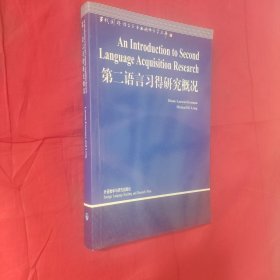
第二语言习得研究概况
正版保障 假一赔十 可开发票
¥ 29.5 6.2折 ¥ 47.9 全新
仅1件
作者DianeLarsen-Freeman,MichaelH.Long著
出版社外语教学与研究出版社
ISBN9787560020105
出版时间2000-08
装帧平装
开本16开
定价47.9元
货号6577856
上书时间2024-08-30
- 最新上架
商品详情
- 品相描述:全新
- 商品描述
-
目录
Preface by Hallday
General Editors Preface
Authors Preface
Acknowledgements
1 Introduction
1.1 The place of second language in the world today
1.2 Why study second language acquisition?
1.3 Development of the field of study of second language acquisition
1.4 The scope of second lanb, uage acquisition research
Notes
Activities
Suggestions for further reading
2 Second language acquisition research methodology
2.1 Introduction
2.2 Qualitative versus quantitative methodologies
2.2.1 Introspection
2.2.2 Participant observatiorf
2.2.3 Non-participant observation
2.2.4 Focused description
2.2.5 Pre-experiment
2.2.6 Quasi-experimem
2.2.7 Experiment
2.3 Setting
2.4 Instrumentation: production data elicitation
2.5 Variability problem
2.6 Instrumentation: intuitional data elicitation
2.7 Instrumentation: use of miniature,languages
2.8 Instrumentation: affective variables
2.9 Instruments from other disciplines
2.10 Measuring learner performance
2.10.1 Defining language proficiency
2.10.2 Defining an acquisition point
2.10.3 Taskversus test
2.10.4 An index of development
2.11 Conclusion
Notes
Activities
Suggestions for further reading
3 SLA: Types of data analysis
3.1 Introduction
3.2 Contrastive analysis
3.2.1 The contrastive analysis hypothesis
3.2.2 Language acquisition as habit formation
3.2.3 The CAH refuted
3.3 Error analysis
3.3.1 Strong versus weak Versions of the CAH
3.3.2 Language acquisition as rule formation
3.3.3 Interlingual versus intralingual errors
3.3.4 Interlanguage
3.3.5 Error analysis criticized
3.4 Performance analysis
3.4.1 Morpheme studies
3.4.2 Developmental sequence
3.4.3 Learner strategies
3.4.4 The acquisition of forms and functions
3.4.5 Formulaic utterances
3.5 Discourse analysis
3.5.1 Conversational analysis
3.5.2 Other applications of discourse analysis
3.6 Conclusion
Notes
Activities
Suggestions for further reading
4 Interlanguage studies: Substantive fmdings
4.1 Introduction
4.2 ILs vary systematically
4.2.1 Free variation
4.2.2 Systematic vatriability
4.2.3 Variability resulting from amount of attention
4.2.4 Free variation as an impetus for development
4.2.5 Multiple explanations for variability
4.3 ILs exhibit common acquisition orders and developmental sequences
4.3.1 Acquisition order: morpheme studies
4.3.2 Developmental sequence: interrogatives
4.3.3 Developmental sequence: negation
4.4 ILs are influenced by the learners L1
4.4.1 The effect of the L1 on SLA: how
4.4.2 The effect of the L1 on SLA: when (markedness)
4.4.3 The effect of the L1 on SLA: when (perceived transferability)
Notes
Activities
Suggestions for further reading
5 The linguistic environment for language acquisition
5.1 Linguistic input for first language acquisition
5.2 Linguistic input for second language acquisition
5.2.1 Linguistic adjustments to non-native speakers
5.2.2 Conversational adjustments to non-native speakers
5.3 Does the linguistic environment make a difference?
5.3.1 The effect of deviant input
5.3.2 The role of conversation in developing syntax
5.3.3 Input frequency-accuracy order relationships
5.3.4 Input modification and second languagecomprehension
5.3.5 Comprehensible input and second language
acquisition
Notes
Activities
Suggestions for further reading
6 Explanations for differential success among second language learners
6.1 Introduction
6.2 Age
6.2.1 Studies of age and SLA
6.2.2 Explanations for age-related differences
6.3 Aptitude
6.4 Social-psychological factors
6.4.1 Motivation
6.4.2 Attitude
6.5 Personality
6.6 Cognitive style
6.7 Hemisphere specialization
6.8 Learning strategies
6.9 Other factors
6.10 Conclusion
Notes
Activities
Suggestions for further reading
7 Theories in second language acquisition
7.1 Introduction
7.2 Theory construction and social science
7.2.1 The role of theories in making research cumulative
7.2.2 Purposes a~d types of theory
7.3 Nativist theories of SLA
7.3.1 General characteristics
7.3.2 Chomskys Universal Grammar and SLA
7.3.3 A critique of language-specific nativist theories
7.3.4 Krashens Monitor Theory
7.3.5 A critique of Monitor Theory
7.4 Environmentalist theories of SLA
7.4.1 General characteristics
7.4,2 Schumanns Pidginization Hypothesis and Acculturation Model
7.4.3 A critique of the Pidginization Hypothesis and Acculturation Model
7.5 Interactionisttheories of SLA
7.5.1 General characteristics
7.5.2 Givons Functional-Typological Theory and SLA
7.5.3 A critique of Givons theory in SLA research
7.5.4 The ZISAs groups Multidimensional Model
7.5.5 A critique of the Multidimensional Model
7.6 Conclusion: the state of SLA theories
7.6.1 Comparing and evaluating theories
7.6.2 A note of caution
Notes
Activities
Suggestions for further reading
8 Instructed second language acquisition
8.1 Introduction
8.2 Early research on the effect of instruction, and some claimed implications
8.3 The effect of instruction on accuracy orders and developmental sequences
8.4 The effect of instruction on acquisition processes
8.5 The effect of instruction on rate of acquisition
8.6 The effect of instruction on the level of ultimate SL attainment
8.7 Conclusion
8.8 Explanations
8.9 Researching instructional design features
Notes
Activities
Suggestions for further reading
Epilogue
Bibliography
Index
内容摘要
70年代末和80年代初,Krashen提出了“监察理论”,其核心是五项基本假说:语言习得与学习假说、监察假说、自然顺序假说、语言输入假说和情感过滤假说。Krashen认为第二语言习得涉及两种不同的过程:习得过程和学习过程。“习得”主要指以获取信息或以信息交流为目的的语言习得过程,在这一过程中学习者关注的是“意义”而不是“语言形式”。与此相反,“学习”是指有意识的语言规则的学习,在这一过程中,学习者关注的是语言形式和语法规则。“学习”和“习得”是两种既不相同,又不能相互沟通或转换的过程。通过“学习”掌握的语言知识无法转化为语言习得系统的知识,也不能用来在自然交际环境中表达说话者想要表达的意义,而只能发挥“监察”的作用。“监察”是学习者对自己语言输出的质量进行有意识的监督,它可以发生在语言输出之前、语言输出期间或语言输出之后。自然顺序假说提出,第二语言规则的习得是以一种可预示的顺序逐步掌握的,某些规则的掌握往往要先于另一些规则的掌握,这种顺序具有普遍性。此外,有迹象表明这种顺序与课堂语言教学的顺序无关。输入假说是“监察理论”的核心内容,Krashen认为,学习者是通过对语言输入的理解而逐步习得第二语言的,“可理解的语言输入”(comprehensibleinptlt)是语言习得的必要条件。所谓“可理解的语言输入”是指语言输入既不能太难,也不能太容易,它应当稍微高于学习者目前的语言水平。只有当学习者接触到的语言材料是“可理解的”,才能对第二语言的发展产生积极作用。*后,Krashen试图以情感过滤假说来解释为什么学习者的学习速度不同,他们*终达到的语言水平也参差不齐。按照Krashen的观点,接受可理解的语言输入是语言习得的必要条件而不是充分条件,学习者差异的存在不仅是由于他们接受的可理解的语言输入的量不同,还在于不同的情感因素在语言习得过程中产生的影响。不恰当的情感(如学习动力不够、过度焦虑等)会对语言输入产生阻碍,使其无法进入语言习得机制,当然也就不能进行语言习得。Krashen用下图来表示这五项假设与第二语言习得的关系。
精彩内容
Understanding how people learn and fail to learn second and foreign languages is increasingly recognized as a critical social and psycholinguistic issue. Second languages are vitally important to diverse groups of people, ranging from refugees to college students facing foreign language requirements. An Introduction to Second Language Acquisition Research provides a synthesis of empirical findings on second and foreign language learning by children and adults. emphasising the desing and execution of appropriate research. The book assumes no prior knowledge of SLA. and introduces major topics such as the scope of SLA research. research methodology for gathering and analysing data, the history and development of SLA research and substantive findings on interlanguage development. explanations for success and failure, the role of theory in social science, current theories of SLA. and the effects of formal instruction on language learning. The volume also includes an extensive bibliography and suggestions for further reading, as well as discussion questions and problems to accompany each chapter. An Introduction to Second Language Acquisition Researc is a comprehensive, yet highly accessible study which will prove invaluable for language teachers and teachers in raining, as well as discusion questions and problems to accompany each chapter. An Introduction to Second Language Acquisition Research is a comprehensive, yet highly accessible study which will prove invaluable for language teachers and teachers in training, as well as students in applied linguistics, linguistics, psychology, psycholinguistics and foreign language education. Diane Larsen-Freeman is a Senior Faculty Member in the MAT Program at the Sehool of International Training.Vermont. USA and Michael H. Long is Professor of English as a Second Language, at the University of Hawaii,USA.




















以下为对购买帮助不大的评价